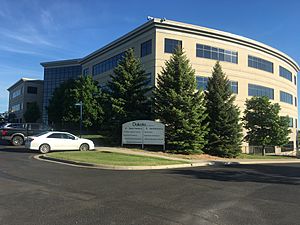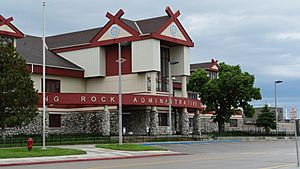Government of North Dakota facts for kids
As with the federal government of the United States, political power in North Dakota state government is divided into three branches: executive, legislative, and judicial.
The Constitution of North Dakota and the North Dakota Century Code form the formal law of the state; the North Dakota Administrative Code incorporates additional rules and policies of state agencies.
In a 2020 study, North Dakota was ranked as the 8th easiest state for citizens to vote in.
Executive
The executive branch is headed by the elected governor. The current governor is Doug Burgum, a Republican who took office December 15, 2016, after his predecessor, Jack Dalrymple did not seek reelection. The current Lieutenant Governor of North Dakota is Brent Sanford, who is also the President of the Senate. The offices of governor and lieutenant governor have four-year terms, which are next up for election in 2024. The governor has a cabinet consisting of appointed leaders of various state government agencies, called commissioners. The other elected constitutional offices are secretary of state, attorney general, state auditor, and state treasurer.
Legislative
The North Dakota Legislative Assembly is a bicameral body consisting of the Senate and the House of Representatives. The state has 47 districts, each with one senator and two representatives. Both senators and representatives are elected to four-year terms. The state's legal code is named the North Dakota Century Code.
Judicial
North Dakota's court system has four levels, one of which is dormant. Municipal courts serve the cities. Decisions from municipal courts are generally appealable to district court. Most cases start in the district courts, which are courts of general jurisdiction. There are 42 district court judges in seven judicial districts. Appeals from final district court decisions are made to the North Dakota Supreme Court. An intermediate court of appeals was provided for by statute in 1987, but the North Dakota Court of Appeals has only heard 65 cases since its inception. The North Dakota Court of Appeals is essentially dormant, but capable of meeting if the North Dakota Supreme Court's case load necessitates the reestablishment of intermediate review.
Indian tribes and reservations
Historically, North Dakota was populated by the Mandan, Hidatsa, Lakota, and Ojibwe, and later by the Sanish and Métis. Today, five federally recognized tribes within the boundaries of North Dakota have independent, sovereign relationships with the federal government and territorial reservations:
- Mandan, Hidatsa, and Arikara Nation, Fort Berthold Reservation;
- Sisseton Wahpeton Oyate, Lake Traverse Indian Reservation;
- Standing Rock Sioux, Standing Rock Indian Reservation;
- Spirit Lake Tribe, Spirit Lake Reservation; and
- Turtle Mountain Band of Chippewa Indians, Turtle Mountain Reservation.
Federal
North Dakota's United States Senators are John Hoeven (R) and Kevin Cramer (R). The state has one at-large congressional district represented by Representative Kelly Armstrong (R).
Federal court cases are heard in the United States District Court for the District of North Dakota, which holds court in Bismarck, Fargo, Grand Forks, and Minot. Appeals are heard by the Eighth Circuit Court of Appeals based in St. Louis, Missouri.



